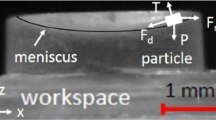Abstract
Various applications of micro-robotic technology suggest the use of new actuator systems which allow motions to be realized with micrometer accuracy. Conventional actuation techniques such as hydraulic or pneumatic systems are no longer capable of fulfilling the demands of hi-tech micro-scale areas such as miniaturized biomedical devices and MEMS production equipment. These applications pose significantly different problems from actuation on a large scale. In particular, large scale manipulation systems typically deal with sizable friction, whereas micro manipulation systems must minimize friction to achieve submicron precision and avoid generation of static electric fields. Recently, the magnetic levitation technique has been shown to be a feasible actuation method for micro-scale applications. In this paper, a magnetic levitation device is recalled from the authors’ previous work and a control approach is presented to achieve precise motion control of a magnetically levitated object with sub-micron positioning accuracy. The stability of the controller is discussed through the Lyapunov method. Experiments are conducted and showed that the proposed control technique is capable of performing a positioning operation with rms accuracy of 16 μm over a travel range of 30 mm. The nonlinear control strategy proposed in this paper showed a significant improvement in comparison with the conventional control strategies for large gap magnetic levitation systems.




Similar content being viewed by others
References
Alvarez-Sanchez E, Alvarez-Gallegos J, Castro-Linares R (2005) Modeling and controller design of a magnetic levitation system. Second International Conference on Electrical and Electronics Engineering 5:330–334
Chen MY, Wang CC, Fu LC (2001) Adaptive sliding mode controller design of a dual-axis maglev positioning system. Proceedings of the 2001 American Control Conference 5:3731–3736
Chen MY, Tsai CF, Fu LC (2004) Design and control of a 2D-electro-magnetic suspension actuator. Proceedings of the 2004 IEEE International Conference on Control Applications 1:93–98
Fallaha C, Kanaan H, Saad M (2005) Real time implementation of a sliding mode regulator for current-controlled magnetic levitation system. Proceedings of the 2005 IEEE International symposium on intelligent control 1:696–701
Jalili-Kharaajoo M (2003) Sliding mode control of voltage-controlled magnetic levitation systems. Proceedings of 2003 IEEE Conference on Control Applications 1:83–86
Jalili-Kharaajoo M (2004) Robust variable structure control applied to voltage controlled magnetic levitation systems. 2nd IEEE International Conference on Industrial Informatics 1:335–338
Jiunshian P, Jianming L, Yasser M, Yahaghi T (2005) Neuro-sliding mode control for magnetic levitation systems. IEEE International Symposium on Circuits and Systems (ISCAS 2005) 5:5130–5133
Khamesee M, Kato N, Nomura Y (2002) Design and control of a microrobotic system using magnetic levitation. IEEE ASME Trans Mechatron 7(1):1–14
Khamesee M, Kato N, Nomura Y (2003) Performance improvement of a magnetically levitated microrobot using an adaptive control. Proceedings of the International Conference on MEMS NANO and Smart Systems 1:332–338
Khamesee MB, Shameli E (2005) Regulation technique for a large gap magnetic field for third non-contact manipulation. J Mechatron 15(9):1073–1087
Lepetic M, Skrjanc I, Chiacchiarini HG, Matko D (2001) Predictive control based on fuzzy model: a case study. The 10th IEEE International Conference on Fuzzy Systems 3:868–871
Peng Y, Qiang Z, Lianbing L (2002) Design of fuzzy weight controller in singleaxis magnetic suspension system. Proceedings of the fourth World Congress on Intelligent Control and Automation 4:3027–3030
Shakir H, Won-jong K (2005) Nanoscale path planning and motion control. Proc 2005 American Control Conf 5:3604–3609
Shih-Kang K, Ximin S, Chia-Hsiang M (2003) Large travel ultra precision x− y− θ motion control of a magnetic-suspension stage. IEEE ASME Trans Mechatron 8(3):334–341
Slotine JJ (1991) Applied nonlinear control. Englewood Cliffs, Prentice-Hall, NJ
Ximin S, Shih-Kang K, Jihua Z, Chia-Hsiang M (2002a) Ultra precision motion control of a multiple degrees of freedom magnetic suspension stage. IEEE ASME Trans Mechatron 7(1):67–78
Ximin S, Chia-Hsiang M (2002b) Robust disturbance rejection for improved dynamic sti.ness of a magnetic suspension stage IEEE ASME Trans Mechatron 7(3):289–295
Yen-Chen C, Shinq-Jen W, Tsu-Tian L (2003) Minimum-energy neural-fuzzy approach for current/voltage-controlled electromagnetic suspension system, Proceedings of the 2003 IEEE International Symposium on Computational Intelligence in Robotics and Automation 3:1405–1410
Author information
Authors and Affiliations
Corresponding author
Rights and permissions
About this article
Cite this article
Shameli, E., Khamesee, M.B. & Huissoon, J.P. Nonlinear controller design for a magnetic levitation device. Microsyst Technol 13, 831–835 (2007). https://doi.org/10.1007/s00542-006-0284-y
Received:
Accepted:
Published:
Issue Date:
DOI: https://doi.org/10.1007/s00542-006-0284-y




